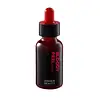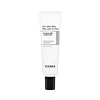What's inside
What's inside
 Key Ingredients
Key Ingredients

 Benefits
Benefits

 Concerns
Concerns

 Ingredients Side-by-side
Ingredients Side-by-side

Water
Skin ConditioningGlycolic Acid 8%
BufferingButylene Glycol
HumectantGlycerin
Humectant1,2-Hexanediol
Skin ConditioningNiacinamide
SmoothingPotassium Hydroxide
BufferingXanthan Gum
EmulsifyingGardenia Florida Fruit Extract
Skin ConditioningDextrin
AbsorbentSalicylic Acid
MaskingGluconolactone
Skin ConditioningTheobroma Cacao Extract
Skin ConditioningPropanediol
SolventEthylhexylglycerin
Skin ConditioningDisodium EDTA
Sodium Hyaluronate
HumectantCapryloyl Salicylic Acid
ExfoliatingAloe Barbadensis Leaf Extract
EmollientMalus Domestica Fruit Extract
AntioxidantBeta Vulgaris Root Extract
Skin ConditioningVaccinium Macrocarpon Fruit Extract
AstringentSolanum Lycopersicum Fruit Extract
AntioxidantRubus Idaeus Fruit Extract
AstringentPunica Granatum Fruit Extract
AntioxidantMalpighia Emarginata Fruit Extract
Skin ConditioningCapsicum Annuum Fruit Extract
AntimicrobialDaucus Carota Sativa Root Extract
Skin ConditioningHippophae Rhamnoides Fruit Juice
Skin ConditioningMaltodextrin
AbsorbentHydrolyzed Pea Protein
EmollientPhytosterols
Skin ConditioningSqualane
EmollientOlea Europaea Fruit Oil
MaskingLecithin
EmollientCeramide NP
Skin ConditioningCaprylyl Glycol
EmollientButyrospermum Parkii Butter
Skin ConditioningWater, Glycolic Acid 8%, Butylene Glycol, Glycerin, 1,2-Hexanediol, Niacinamide, Potassium Hydroxide, Xanthan Gum, Gardenia Florida Fruit Extract, Dextrin, Salicylic Acid, Gluconolactone, Theobroma Cacao Extract, Propanediol, Ethylhexylglycerin, Disodium EDTA, Sodium Hyaluronate, Capryloyl Salicylic Acid, Aloe Barbadensis Leaf Extract, Malus Domestica Fruit Extract, Beta Vulgaris Root Extract, Vaccinium Macrocarpon Fruit Extract, Solanum Lycopersicum Fruit Extract, Rubus Idaeus Fruit Extract, Punica Granatum Fruit Extract, Malpighia Emarginata Fruit Extract, Capsicum Annuum Fruit Extract, Daucus Carota Sativa Root Extract, Hippophae Rhamnoides Fruit Juice, Maltodextrin, Hydrolyzed Pea Protein, Phytosterols, Squalane, Olea Europaea Fruit Oil, Lecithin, Ceramide NP, Caprylyl Glycol, Butyrospermum Parkii Butter
Water
Skin ConditioningGlycolic Acid
BufferingLactic Acid
BufferingPotassium Hydroxide
BufferingGluconolactone
Skin ConditioningMandelic Acid
AntimicrobialDipropylene Glycol
HumectantPanthenol
Skin ConditioningSalicylic Acid 2%
MaskingMethylpropanediol
Solvent1,2-Hexanediol
Skin ConditioningOctyldodeceth-16
EmulsifyingCitric Acid
BufferingHydroxyethylcellulose
Emulsion StabilisingPentylene Glycol
Skin ConditioningSodium Polyacryloyldimethyl Taurate
Emulsion StabilisingCyanocobalamin
Skin ConditioningPolyacrylate Crosspolymer-6
Emulsion StabilisingHydroxypropyl Starch Phosphate
Ethylhexylglycerin
Skin ConditioningCapryloyl Salicylic Acid
ExfoliatingPolysorbate 60
EmulsifyingDisodium Phosphate
BufferingSodium Phosphate
BufferingTocopherol
AntioxidantAllantoin
Skin ConditioningHydrolyzed Hyaluronic Acid
HumectantWater, Glycolic Acid, Lactic Acid, Potassium Hydroxide, Gluconolactone, Mandelic Acid, Dipropylene Glycol, Panthenol, Salicylic Acid 2%, Methylpropanediol, 1,2-Hexanediol, Octyldodeceth-16, Citric Acid, Hydroxyethylcellulose, Pentylene Glycol, Sodium Polyacryloyldimethyl Taurate, Cyanocobalamin, Polyacrylate Crosspolymer-6, Hydroxypropyl Starch Phosphate, Ethylhexylglycerin, Capryloyl Salicylic Acid, Polysorbate 60, Disodium Phosphate, Sodium Phosphate, Tocopherol, Allantoin, Hydrolyzed Hyaluronic Acid
 Reviews
Reviews

Ingredients Explained
These ingredients are found in both products.
Ingredients higher up in an ingredient list are typically present in a larger amount.
1,2-Hexanediol is a synthetic liquid and another multi-functional powerhouse.
It is a:
- Humectant, drawing moisture into the skin
- Emollient, helping to soften skin
- Solvent, dispersing and stabilizing formulas
- Preservative booster, enhancing the antimicrobial activity of other preservatives
Capryloyl Salicylic Acid comes from salicylic acid, the famous acne-fighting BHA.
It usually goes by a more common name of LHA, or lipohydroxy acid.
Like salicylic acid, this ingredient is a chemical exfoliant that can help break down the oil in your pores and reduce inflammation.
Though studies for LHA do show it to be less effective than salicylic acid. To be fair, salicylic acid is the reigning monarch of acne treatments.
However, a study from 2009 found LHA to be comparable to BPO, making it a good alternative for people with sensitive skin. Another study of 14 patients found a significant decrease in comedones after using LHA.
Another pro of LHA? It is less irritating than salicylic acid due to its large molecule size.
Large molecules cannot penetrate skin as well, so they are gentler on the skin. LHA is much less penetrative than salicylic acid.
An in-vitro study (not done on a living organism) found only 6% of LHA penetrated past the statum corneum compared to 58% of salicylic acid. An in-vivo (done on a living organism) analysis revealed ~17% of LHA was still present in the top layer of skin after 4 days, versus ~9% of salicylic acid.
Interestingly, a study from 2008 found LHA comparable to another famous acid, glycolic acid.
This study found about 10% of LHA is as effective as 20-50% of glycolic acid in treating hyperpigmentation and fine-lines.
Hydroxy acids have been found to stimulate skin protein, lipids, and thermal thickening. This may have anti-aging benefits.
Learn more about Capryloyl Salicylic AcidEthylhexylglycerin (we can't pronounce this either) is commonly used as a preservative and skin softener. It is derived from glyceryl.
You might see Ethylhexylglycerin often paired with other preservatives such as phenoxyethanol. Ethylhexylglycerin has been found to increase the effectiveness of these other preservatives.
Gluconolactone is a PHA. PHAs are a great gentle alternative to traditional AHAs.
When applied, Gluconolactone has the same affect on skin as AHAs such as lactic acid. It helps dissolve the dead skin cells in the top layer of your skin. This improves texture and brightens the skin.
PHAs are more gentle than AHAs due to their larger structure. They do not penetrate as deeply as AHAs and take a longer time to dissolve dead cells. Studies show PHAs do not cause as much irritation.
Gluconolactone has some interesting properties:
In a 2004 study, Gluconolactone was found to prevent UV damage in mouse skin cells and has not been found to increase sun sensitivity. However, we still recommend wearing SPF daily.
This ingredient is is an created by reacting gluconic acid with an alcohol.
Learn more about GluconolactoneGlycolic Acid is arguably the most famous alpha hydroxy acid (AHA) with tons of research backing its benefits.
It is found naturally in sugar cane but the form used in skincare is usually synthetic for purity and stability.
Glycolic acid removes the top layer of dead skin cells to allow newer and fresher ones to emerge.
AHAs work by breaking down the structural “glue” that holds old skin cells in place. When that buildup is gone, your skin can renew itself more efficiently.
Research also shows glycolic acid stimulates collagen production, helping to firm and thicken the skin over time. This is one of its biggest advantages over other AHAs.
Overall, glycolic acid helps with:
Fun fact: Glycolic acid boosts skin hydration by helping it produce molecules that increase hyaluronic acid naturally.
To work best, glycolic acid products should have a pH between 3-4 (that’s where exfoliation is most effective but still gentle on skin).
The pH and concentration of a product are key to its effectiveness:
It is normal to feel a slight stinging sensation when using glycolic acid. This usually fades as your skin adjusts.
Because glycolic acid has the smallest molecular size in the AHA family, it can penetrate deeper, which enhances its effectiveness but also makes it more likely to irritate sensitive skin.
If your skin is very sensitive or prone to rosacea, glycolic acid may be too strong; in that case, try milder options like lactic acid or a PHA instead.
Recent studies suggest glycolic acid might even help protect against UV damage. But don’t skip sunscreen! Freshly exfoliated skin is more sensitive to the sun.
Glycolic acid is a skincare superstar. It smooths, brightens, hydrates, and firms the skin. Unless you’re highly sensitive, it’s well worth adding to your routine.
Read more about some other popular AHA's here:
Learn more about Glycolic AcidPotassium hydroxide is commonly known as caustic potash. It is used to fix the pH of a product or as a cleaning agent in soap. In cleansers, it is used for the saponification of oils.
Sapnification is the process of creating fatty acid metal salts from triglycerides and a strong base. During this process, Potassium Hydroxide is used up and is not present in the final product.
Using high concentrations of Potassium Hydroxide have shown to irritate the skin.
Learn more about Potassium HydroxideSalicylic Acid (also known as beta hydroxy acid or BHA) is a well-known ingredient for treating skin that struggles with acne and clogged pores. It exfoliates both the skin's surface and deep within the pores to help clear out buildup, control oil, and reduce inflammation.
Unlike AHAs (alpha hydroxy acids), salicylic acid is oil-soluble. This allows it to penetrate into pores which makes it especially effective for treating blackheads and preventing future breakouts.
Salicylic acid is also known for its soothing properties. It has a similar structure to aspirin and can calm inflamed or irritated skin, making it a good option for acne-prone skin that is also sensitive.
Concentrations of 0.5-2% are recognized by the U.S. FDA as an over-the-counter topical acne product.
It can cause irritation and/or dryness if one's skin already has a compromised moisture barrier, so it's best to focus on repairing that before introducing this ingredient into your routine.
While salicylic acid does not increase sun sensitivity, it’s still important to wear sunscreen daily to protect your skin.
If you are looking for the ingredient called BHA or Butylated Hydroxyanisole, click here.
Learn more about Salicylic AcidWater. It's the most common cosmetic ingredient of all. You'll usually see it at the top of ingredient lists, meaning that it makes up the largest part of the product.
So why is it so popular? Water most often acts as a solvent - this means that it helps dissolve other ingredients into the formulation.
You'll also recognize water as that liquid we all need to stay alive. If you see this, drink a glass of water. Stay hydrated!
Learn more about Water